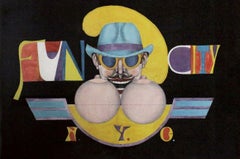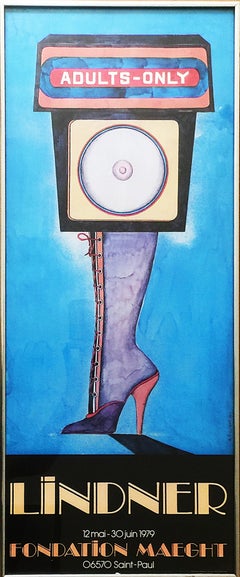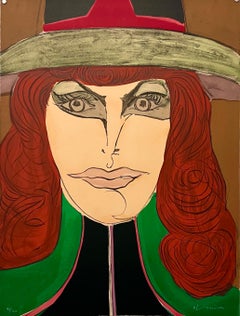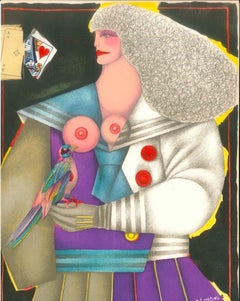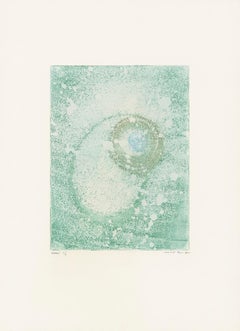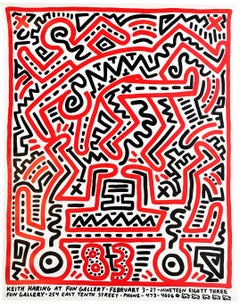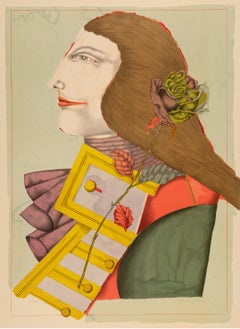Richard Lindner Figurative Prints
American, 1901-1978
Richard Lindner (1901 – 1978) was a German-American painter. Lindner's mother was owner of a custom-fitting corset business and Richard Lindner grew up and studied at the Kunstgewerbeschule (Arts and Crafts School since 1940 Academy of Fine Arts). From 1924 to 1927 he lived in Munich and studied there from 1925 at the Kunstakademie. In 1927 Lindner moved to Berlin and stayed there until 1928, when he returned to Munich to become art director of a publishing firm. He remained in Munich until 1933, when he was forced to flee to Paris. Once in Paris, Lindner became politically engaged, sought contact with French artists and earned his living as a commercial artist. He was interned when World War II broke out in 1939 and later served in the French Army. In 1941, Lindner moved to the United States and worked in New York City as an illustrator of books and magazines. There he made contact with New York artists and German emigrants such as Albert Einstein, Marlene Dietrich, and Saul Steinberg. In 1948, Lindner became an American citizen. Lindner taught at a number of institutions including the Pratt Institute, Brooklyn, Hochschule fur bildende Kunste in Hamburg and Yale University School of Art and Architecture. His paintings often used the sexual symbolism of advertising and investigated definitions of gender roles in the media.(Biography provided by ArtWise)
to
3
14
5
4
5
17
2
2
9
5
3
Overall Height
to
Overall Width
to
14
4
1
13
9
8
7
4
3
3
2
1
1
1
1
1
1
1
1
1
19
4
8
1
36
563
396
350
305
19
2
1
Artist: Richard Lindner
Vintage Modern Lithograph Poster 1960s Pop Art Mod Figure
By Richard Lindner
Located in Surfside, FL
Vintage 1960's Lithograph poster for Vancouver Canada art show.
Richard Lindner was born in Hamburg, Germany. In 1905 the family moved to Nuremberg, where Lindners mother was owner o...
Category
1960s Pop Art Richard Lindner Figurative Prints
Materials
Lithograph
Fun City, N.Y.C.
By Richard Lindner
Located in New York, NY
A very good impression of this color lithograph. Signed and numbered 125/175 in pencil, lower margin.
Category
1970s Pop Art Richard Lindner Figurative Prints
Materials
Color, Lithograph
Adults-Only
By Richard Lindner
Located in New York, NY
Richard Lindner
Adults-Only, 1979
Offset lithograph poster
Plate signature with date, right front
Frame Included: held in vintage 1970s metal period frame
This is a rare vintage post...
Category
1970s Pop Art Richard Lindner Figurative Prints
Materials
Lithograph, Offset
1971 Modernist Lithograph Redhead Pop Art Mod Fashionable Woman Richard Lindner
By Richard Lindner
Located in Surfside, FL
RICHARD LINDNER (American. 1901-1978)
Hand Signed limited edition lithograph with blindstamp
Publisher: Shorewood-Bank Street Atelier for the Skowhegan School of Painting and Sculpture
29.25 X 22 inches
Richard Lindner was born in Hamburg, Germany. In 1905 the family moved to Nuremberg, where Lindner's mother was owner of a custom-fitting corset business and Richard Lindner grew up and studied at the Kunstgewerbeschule (Arts and Crafts School since 1940 Academy of Fine Arts). From 1924 to 1927 he lived in Munich and studied there from 1925 at the Kunstakademie. In 1927 he moved to Berlin and stayed there until 1928, when he returned to Munich to become art director of a publishing firm. He remained there until 1933, when he was forced to flee to Paris, where he became politically engaged, sought contact with French artists and earned his living as a commercial artist. He was interned when the war broke out in 1939 and later served in the French Army. In 1941 he went to the United States and worked in New York City as an illustrator of books and magazines (Vogue, Fortune and Harper's Bazaar). He began painting seriously in 1952, holding his first one-man exhibit in 1954. His style blends a mechanistic cubism with personal images and haunting symbolism. LIndner maintained contact with the emigre community including New York artists and German emigrants (Albert Einstein, Marlene Dietrich, Saul Steinberg). Though he became a United States citizen in 1948, Lindner considered himself a New Yorker, but not a true American. However, over the course of time, his continental circus women became New York City streetwalkers. New York police uniforms replaced European military uniforms as symbols of authority.At a time when Abstract Expressionism was all the rage, Lindner’s painting went against the current and always kept its distance. His pictorial language of vibrant colours and broad planes of colour and his urban themes make him a forerunner of American Pop Art. At the same time, he owes the critical tone of his paintings to the influence of European art movements such as Neue Sachlichkeit and Dada. His first exhibition did not take place until 1954, by which time he was over fifty, and, interestingly, it was held at the Betty Parsons Gallery in New York, a venue associated with the American Expressionists. From 1952 he taught at the Pratt Institute, Brooklyn, from 1967 at Yale University School of Art and Architecture, New Haven. In 1957 Lindner got the William and Norma Copley Foundation-Award. In 1965 he became Guest Professor at the Akademie für Bildende Künste, Hamburg. His Ice (1966, Whitney Museum of American Art) established a connection between the metaphysical tradition and pop art. He did work on Rowlux which was used by a number of pop artists (most notably Roy Lichtenstein)The painting shows harsh, flat geometric shapes framing an erotic but mechanical robot-woman. His paintings used the sexual symbolism of advertising and investigated definitions of gender roles in the media. While influencing Pop Art (Andy Warhol, Tom Wesselmann and Claes Oldenburg amongst others) his highly colourful, hard-edge style seems to have brought him close to Pop Art, which he rejected. Nevertheless, he is immortalised on the cover of the Beatles record "Sgt. Pepper’s Lonely Hearts Club Band" (1967) as a patron of the pop culture. He also did a tapestry banner with the Betsy Ross Flag...
Category
1970s Pop Art Richard Lindner Figurative Prints
Materials
Lithograph
Untitled - Original Lithograph by R. Lindner - 1974
By Richard Lindner
Located in Roma, IT
Untitled from Le XX Siècle is an original artwork realized by Richard Lindner in 1974.
Original colored lithograph.
Good conditions. Printed by Mourlot, France.
This lithograph wa...
Category
1970s Surrealist Richard Lindner Figurative Prints
Materials
Lithograph
Portrait #1 from After Noon suite
By Richard Lindner
Located in San Francisco, CA
This artwork titled "Portrait #1" from the suite "After Noon" 1976, is an original color lithograph on Arches paper by artist Richard Lindner (German/American 1901-1978) It is hand s...
Category
Mid-20th Century Pop Art Richard Lindner Figurative Prints
Materials
Lithograph
How it all Began from the "After Noon" Portfolio, Lithograph by Richard Lindner
By Richard Lindner
Located in Long Island City, NY
Artist: Richard Lindner, German/American (1901 - 1978)
Title: How it all Began from the "After Noon" Portfolio
Year: 1969
Medium: Lithograph on Arches, signed and numbered in pencil
...
Category
1960s Pop Art Richard Lindner Figurative Prints
Materials
Lithograph
1970's New York original lithograph by Richard Lindner
By Richard Lindner
Located in Petworth, West Sussex
A funky urban image from 1971 depicting some of the nuances of New York seedy underbelly. This original lithograph is number 73 of and edition of 75 from the 1971 'Fun City' suite. Originally there were 12 different artworks in this series by Richard Lindner of which this is the title piece.
Signed in pencil 'R Lindner...
Category
Late 20th Century Modern Richard Lindner Figurative Prints
Materials
Lithograph
Lady of Heart - Original lithograph - Mourlot 1974
By Richard Lindner
Located in Paris, FR
Richard LINDNER
Lady of Heart (1974)
Original lithograph (Mourlot workshop)
Printed signature in the plate
On vellum 31 x 24 cm (c. 12 x 10 in)
Very good condition
Category
1970s Pop Art Richard Lindner Figurative Prints
Materials
Lithograph
Masked Woman Signed Lithograph
By Richard Lindner
Located in Rio Vista, CA
Richard Lindner (German/American 1901-1978) original hand signed in pencil lithograph "Masked Woman". Unframed #16 of 100 dated and stamped lower right 1971.
Category
20th Century Modern Richard Lindner Figurative Prints
Materials
Paper, Lithograph
Shoot, Pop Art Lithograph by Richard Lindner 1969
By Richard Lindner
Located in Long Island City, NY
Artist: Richard Lindner, German/American (1901 - 1978)
Title: Shoot
Year: 1969
Medium: Lithograph, signed and numbered in pencil
Edition: 158/175
Size: 25 in. x 20 in. (63.5 cm x 50....
Category
1960s Pop Art Richard Lindner Figurative Prints
Materials
Lithograph
Hit
By Richard Lindner
Located in Long Island City, NY
Artist: Richard Lindner
Title: Hit
Year: 1971
Medium: Lithograph and Collage on Blue Rowlux, signed and numbered in pencil
Edition: 175
Paper Size: 25 x 20 inches
Produced and publi...
Category
1970s Pop Art Richard Lindner Figurative Prints
Materials
Lithograph
St. Marks, Pop Art Lithograph and Collage by Richard Lindner
By Richard Lindner
Located in Long Island City, NY
Artist: Richard Lindner, German/American (1901 - 1978)
Title: St. Marks
Year: 1971
Medium: Lithograph and Collage on Gray Rowlux, Signed and Numbered in Pencil
Edition: 88/175
Size: ...
Category
1970s Pop Art Richard Lindner Figurative Prints
Materials
Lithograph
Shoot "Back" Lithograph
By Richard Lindner
Located in Rio Vista, CA
Unframed Richard Lindner (German/American 1901-1978) original hand signed in pencil lithograph #16 of a series of 100 dated and stamped lower right 1971. Shoot (back) from a series o...
Category
20th Century Pop Art Richard Lindner Figurative Prints
Materials
Paper, Lithograph
Lovers with a Tiger - Lithograph, Maeght 1977
By Richard Lindner
Located in Paris, FR
Richard LINDNER
Lovers with a Tiger
Original lithograph, 1977
Printed signature in the plate
On heavy paper 76 x 56 cm (c. 30 x 22 inch)
Created for the artist exhibition in Maeght ...
Category
1970s American Modern Richard Lindner Figurative Prints
Materials
Lithograph
Read Head
By Richard Lindner
Located in San Francisco, CA
This artwork titled "Red Head" 1971 is an original color lithograph on Wove paper by artist Richard Lindner (German/American 1901-1978) It is hand signed and inscribed A.P (Artist Pr...
Category
Mid-20th Century Pop Art Richard Lindner Figurative Prints
Materials
Lithograph
Alliance in Art, Pop Art Silkscreen by Richard Lindner 1968
By Richard Lindner
Located in Long Island City, NY
Artist: Richard Lindner
Title: Alliance in Art
Year: 1968
Medium: Silkscreen, Signed and Numbered in Pencil, on illustration board.
Edition: 24/50
Paper Size: 27.5 x 19.5 inches (69....
Category
1960s Pop Art Richard Lindner Figurative Prints
Materials
Lithograph
American Pop art artist, Richard Lindner exhibition poster
By Richard Lindner
Located in Petworth, West Sussex
Richard Lindner (German-American, 1901-1978)
An Art exhibition poster for Lennox Hill Hospital and Skowhegan School of painting and sculpture, 1967
Artist’s proof
Signed in pencil ‘R...
Category
Mid-20th Century Modern Richard Lindner Figurative Prints
Materials
Lithograph
Der Rosenkavalier, Pop Art Lithograph by Richard Lindner
By Richard Lindner
Located in Long Island City, NY
Artist: Richard Lindner, German/American (1901 - 1978)
Der Rosenkavalier from the Metropolitan Opera I, 1978
Lithograph, signed and numbered in pencil
29-3/4 x 21-3/4 inches (75.6 x ...
Category
1980s Pop Art Richard Lindner Figurative Prints
Materials
Lithograph
Related Items
"Terre des nébuleuses" by Max Ernst, Blue, Fog, Surrealism
By Max Ernst
Located in Köln, DE
Etching and aquatint in colours (colour variation) by Max Ernst.
"Terre des nébuleuses", 1965
38 x 27,5 cm
Copy essai 1/1
Category
1960s Surrealist Richard Lindner Figurative Prints
Materials
Etching, Aquatint
Keith Haring Fun Gallery exhibition poster 1983 (vintage Keith Haring)
By Keith Haring
Located in NEW YORK, NY
Keith Haring Fun Gallery 1983:
Original 1983 Keith Haring illustrated exhibition poster published on the occasion of Haring's historic 1983 show at the Fun Gallery in the East Village. A classic array of early Haring imagery that reveals red and black interlocking figures. A rare example in very good overall vintage condition.
Offset lithograph in colors on smooth wove paper.
23 x 29 inches.
Only some minor signs of handling; in otherwise very good overall vintage condition with strong colors; one of the better examples we've come across. Stored away from light; never mounted or framed.
Unsigned from an edition of unknown; scarce.
Catalog Raisonne:
Keith Haring: Posters (Prestel Publishing).
References:
Included in the collection of the Cooper Hewitt, Smithsonian Design Museum.
About the Fun Gallery:
Historic, short-lived, East Village gallery known for giving Keith Haring, Basquiat & Kenny Scharf some of their first solo shows.
“FUN Gallery was a place where neighborhood kids, downtown artists, b-boys, rock, film, and rap stars mixed with museum directors art historians and uptown collectors at wild openings featuring artists like Futura, Fab 5...
Category
1980s Pop Art Richard Lindner Figurative Prints
Materials
Lithograph, Offset
The Old Professor (Oo La La) Jim Dine lithograph and Ron Padgett poetry
By Jim Dine
Located in New York, NY
Bright orange leaps up like flames, or swaying grass, over which hovers a large-eyed bee sketched in black and orange. Over the fire-red in neat handwriting Ron Padgett...
Category
1970s Pop Art Richard Lindner Figurative Prints
Materials
Lithograph
Five Hearts for Channel 13 (Public Television), deluxe hand signed limited ed.
By Jim Dine
Located in New York, NY
Jim Dine
Love for Channel 13
Lithograph. Hand signed and numbered recto
27 × 21 1/2 inches
Edition 185/200
Signed and numbered 185/200 in graphite pencil on the recto
Unframed
Rarel...
Category
1960s Pop Art Richard Lindner Figurative Prints
Materials
Lithograph, Offset, Pencil
Marc Chagall - The Candlestick - Original Lithograph
By Marc Chagall
Located in Collonge Bellerive, Geneve, CH
The Candlestick, from Jean Leymarie, Vitraux pour Jérusalem (Jerusalem Windows), André Sauret, Monte Carlo, 1962 (see M. 366-72; see C. books ...
Category
1960s Surrealist Richard Lindner Figurative Prints
Materials
Lithograph
Expressive Painting After Picasso catalog 1983 (Basquiat cover)
By after Jean-Michel Basquiat
Located in NEW YORK, NY
Basquiat Cover Art 1983:
Rare early 1980s exhibition catalogue published on the occasion of: “Expressive Painting After Picasso”- a group featuring works by: Pablo Picasso, Jean-Michel Basquiat, Francis Bacon, Georg Baselitz, Joan Miro & more at the Beyeler Gallery, Basel Switzerland.
Medium: Exhibition catalog 1983; softcover, 48 pages.
Dimensions: 10 x 11.5 Inches
Very good overall vintage condition.
Unsigned from an edition of unknown.
Jean-Michel Basquiat’s dramatic life and iconic paintings—which variously feature obsessive scribbling, enigmatic symbols and diagrams, and iconography including skulls, masks, and the artist’s trademark crown—make him one of the most famous artists of the 20th century. The self-taught painter embraced graffiti before committing to a studio practice. He found a mentor and friend in Andy Warhol, who helped the young artist navigate the 1980s New York art world. Across his oeuvre, Basquiat drew on his own Caribbean heritage; a convergence of African American, African, and Aztec cultural histories; classical themes; and pop cultural figures including athletes and musicians. The immediacy and intellectual depth of his paintings won him widespread acclaim both before and after his untimely death at the age of 27. Basquiat’s paintings now belong in the collections of the Museum of Modern Art, the Museum of Contemporary Art, Los Angeles, the Whitney Museum of American Art, and the Metropolitan Museum of Art, among others. In 2017, Basquiat’s Untitled (1982) notched $110.5 million at auction and became the most expensive artwork by an American artist to ever be sold.
Related Categories:
Basquiat ephemera. Basquiat Picasso. Vintage Basquiat. Basquiat 1983.
Category
1980s Pop Art Richard Lindner Figurative Prints
Materials
Paper, Lithograph, Offset
Marc Chagall - Daphnis and Chloé - Original Lithograph
By Marc Chagall
Located in Collonge Bellerive, Geneve, CH
Marc Chagall - Daphnis and Chloé - Original Lithograph
From the literary review "XXe Siècle"
1960
Mourlot N°227
Dimensions: 32 x 24 cm
Publisher: G....
Category
1960s Surrealist Richard Lindner Figurative Prints
Materials
Lithograph
H 12.6 in W 9.45 in D 0.04 in
"Go for Baroque" lithograph poster, hand signed & inscribed by Roy Lichtenstein
By Roy Lichtenstein
Located in New York, NY
Roy Lichtenstein
"Go for Baroque" poster (hand signed and inscribed by Roy Lichtenstein), 1994
Color offset lithograph on wove paper (hand signed and inscribed to Lichtenstein's esta...
Category
1990s Pop Art Richard Lindner Figurative Prints
Materials
Lithograph, Offset, Ink
Marc Chagall - The Red Rider - Original Lithograph
By Marc Chagall
Located in Collonge Bellerive, Geneve, CH
Marc Chagall - Original Lithograph
The Red Rider
From the unsigned, unnumbered lithograph printed in the literary review XXe Siecle
1957
See Mourlot 191
Dimensions: 32 x 24 cm
Publisher: G. di San Lazzaro.
Marc Chagall (born in 1887)
Marc Chagall was born in Belarus in 1887 and developed an early interest in art. After studying painting, in 1907 he left Russia for Paris, where he lived in an artist colony on the city’s outskirts. Fusing his own personal, dreamlike imagery with hints of the fauvism and cubism popular in France at the time, Chagall created his most lasting work—including I and the Village (1911)—some of which would be featured in the Salon des Indépendants exhibitions. After returning to Vitebsk for a visit in 1914, the outbreak of WWI trapped Chagall in Russia. He returned to France in 1923 but was forced to flee the country and Nazi persecution during WWII. Finding asylum in the U.S., Chagall became involved in set and costume design before returning to France in 1948. In his later years, he experimented with new art forms and was commissioned to produce numerous large-scale works. Chagall died in St.-Paul-de-Vence in 1985.
The Village
Marc Chagall was born in a small Hassidic community on the outskirts of Vitebsk, Belarus, on July 7, 1887. His father was a fishmonger, and his mother ran a small sundries shop in the village. As a child, Chagall attended the Jewish elementary school, where he studied Hebrew and the Bible, before later attending the Russian public school. He began to learn the fundamentals of drawing during this time, but perhaps more importantly, he absorbed the world around him, storing away the imagery and themes that would feature largely in most of his later work.
At age 19 Chagall enrolled at a private, all-Jewish art school and began his formal education in painting, studying briefly with portrait artist Yehuda Pen. However, he left the school after several months, moving to St. Petersburg in 1907 to study at the Imperial Society for the Protection of Fine Arts. The following year, he enrolled at the Svanseva School, studying with set designer Léon Bakst, whose work had been featured in Sergei Diaghilev's Ballets Russes. This early experience would prove important to Chagall’s later career as well.
Despite this formal instruction, and the widespread popularity of realism in Russia at the time, Chagall was already establishing his own personal style, which featured a more dreamlike unreality and the people, places and imagery that were close to his heart. Some examples from this period are his Window Vitebsk (1908) and My Fianceé with Black Gloves (1909), which pictured Bella Rosenfeld, to whom he had recently become engaged.
The Beehive
Despite his romance with Bella, in 1911 an allowance from Russian parliament member and art patron Maxim Binaver enabled Chagall to move to Paris, France. After settling briefly in the Montparnasse neighborhood, Chagall moved further afield to an artist colony known as La Ruche (“The Beehive”), where he began to work side by side with abstract painters such as Amedeo Modigliani and Fernand Léger as well as the avant-garde poet Guillaume Apollinaire. At their urging, and under the influence of the wildly popular fauvism and cubism, Chagall lightened his palette and pushed his style ever further from reality. I and the Village (1911) and Homage to Apollinaire (1912) are among his early Parisian works, widely considered to be his most successful and representative period.
Though his work stood stylistically apart from his cubist contemporaries, from 1912 to 1914 Chagall exhibited several paintings at the annual Salon des Indépendants exhibition, where works by the likes of Juan Gris, Marcel Duchamp and Robert Delaunay were causing a stir in the Paris art world. Chagall’s popularity began to spread beyond La Ruche, and in May 1914 he traveled to Berlin to help organize his first solo exhibition, at Der Sturm Gallery. Chagall remained in the city until the highly acclaimed show opened that June. He then returned to Vitebsk, unaware of the fateful events to come.
War, Peace and Revolution
In August 1914 the outbreak of World War I precluded Chagall’s plans to return to Paris. The conflict did little to stem the flow of his creative output, however, instead merely giving him direct access to the childhood scenes so essential to his work, as seen in paintings such as Jew in Green (1914) and Over Vitebsk (1914). His paintings from this period also occasionally featured images of the war’s impact on the region, as with Wounded Soldier (1914) and Marching (1915). But despite the hardships of life during wartime, this would also prove to be a joyful period for Chagall. In July 1915 he married Bella, and she gave birth to a daughter, Ida, the following year. Their appearance in works such as Birthday (1915), Bella and Ida by the Window (1917) and several of his “Lovers” paintings give a glimpse of the island of domestic bliss that was Chagall’s amidst the chaos.
To avoid military service and stay with his new family, Chagall took a position as a clerk in the Ministry of War Economy in St. Petersburg. While there he began work on his autobiography and also immersed himself in the local art scene, befriending novelist Boris Pasternak, among others. He also exhibited his work in the city and soon gained considerable recognition. That notoriety would prove important in the aftermath of the 1917 Russian Revolution when he was appointed as the Commissar of Fine Arts in Vitebsk. In his new post, Chagall undertook various projects in the region, including the 1919 founding of the Academy of the Arts. Despite these endeavors, differences among his colleagues eventually disillusioned Chagall. In 1920 he relinquished his position and moved his family to Moscow, the post-revolution capital of Russia.
In Moscow, Chagall was soon commissioned to create sets and costumes for various productions at the Moscow State Yiddish Theater, where he would paint a series of murals titled Introduction to the Jewish Theater as well. In 1921, Chagall also found work as a teacher at a school for war orphans. By 1922, however, Chagall found that his art had fallen out of favor, and seeking new horizons he left Russia for good.
Flight
After a brief stay in Berlin, where he unsuccessfully sought to recover the work exhibited at Der Sturm before the war, Chagall moved his family to Paris in September 1923. Shortly after their arrival, he was commissioned by art dealer and publisher Ambroise Vollard to produce a series of etchings for a new edition of Nikolai Gogol's 1842 novel Dead Souls. Two years later Chagall began work on an illustrated edition of Jean de la Fontaine’s Fables, and in 1930 he created etchings for an illustrated edition of the Old Testament, for which he traveled to Palestine to conduct research.
Chagall’s work during this period brought him new success as an artist and enabled him to travel throughout Europe in the 1930s. He also published his autobiography, My Life (1931), and in 1933 received a retrospective at the Kunsthalle in Basel, Switzerland. But at the same time that Chagall’s popularity was spreading, so, too, was the threat of Fascism and Nazism. Singled out during the cultural "cleansing" undertaken by the Nazis in Germany, Chagall’s work was ordered removed from museums throughout the country. Several pieces were subsequently burned, and others were featured in a 1937 exhibition of “degenerate art” held in Munich. Chagall’s angst regarding these troubling events and the persecution of Jews in general can be seen in his 1938 painting White Crucifixion.
With the eruption of World War II, Chagall and his family moved to the Loire region before moving farther south to Marseilles following the invasion of France. They found a more certain refuge when, in 1941, Chagall’s name was added by the director of the Museum of Modern Art (MOMA) in New York City to a list of artists and intellectuals deemed most at risk from the Nazis’ anti-Jewish campaign. Chagall and his family would be among the more than 2,000 who received visas and escaped this way.
Haunted Harbors
Arriving in New York City in June 1941, Chagall discovered that he was already a well-known artist there and, despite a language barrier, soon became a part of the exiled European artist community. The following year he was commissioned by choreographer Léonide Massine to design sets and costumes for the ballet Aleko, based on Alexander Pushkin’s “The Gypsies” and set to the music of Pyotr Ilyich Tchaikovsky.
But even as he settled into the safety of his temporary home, Chagall’s thoughts were frequently consumed by the fate befalling the Jews of Europe and the destruction of Russia, as paintings such as The Yellow Crucifixion...
Category
1950s Surrealist Richard Lindner Figurative Prints
Materials
Lithograph
TAKASHI MURAKAMI - FLOWER BALL - BURNING BLOOD Pop Art. Flowers Red Smiley
By Takashi Murakami
Located in Madrid, Madrid
FLOWER BALL - BURNING BLOOD
Date of creation: 2018
Medium: Offset lithograph with silver and high gloss varnishing on paper
Edition number: 30/300
Size: 71 cm Ø
Condition: In mint co...
Category
2010s Pop Art Richard Lindner Figurative Prints
Materials
Silver
Free Shipping
H 27.96 in Dm 27.96 in
Basquiat Paris 1998 (vintage Basquiat announcement)
By after Jean-Michel Basquiat
Located in NEW YORK, NY
Basquiat Paris 1998:
Rare vintage original announcement card to the exhibit, Jean-Michel Basquiat Temoignage 1977-1988, Galerie Jerome De Noirmont, Paris, 1998:
6 x 9 inches (folde...
Category
1980s Pop Art Richard Lindner Figurative Prints
Materials
Offset, Lithograph
Basquiat Enrico Navarra Gallery Paris 1999 (announcement)
By after Jean-Michel Basquiat
Located in NEW YORK, NY
Jean-Michel Basquiat Enrico Navarra Gallery Paris 1999:
Rare vintage Basquiat Mr Chow announcement card published on the occasion of: Jean-Michel Basquiat, Gal...
Category
1980s Pop Art Richard Lindner Figurative Prints
Materials
Paper, Offset
Previously Available Items
Der Rosenkavalier, Pop Art Lithograph by Richard Lindner
By Richard Lindner
Located in Long Island City, NY
Artist: Richard Lindner, German/American (1901 - 1978)
Der Rosenkavalier from the Metropolitan Opera I, 1978
Lithograph, signed and numbered in pencil
29-3/4 x 21-3/4 inches (75.6 x ...
Category
1980s Pop Art Richard Lindner Figurative Prints
Materials
Lithograph
Modernist Lithograph Lovers Kiss Pop Art Mod Figure Richard Lindner Graphic Art
By Richard Lindner
Located in Surfside, FL
RICHARD LINDNER (American. 1901-1978)
32/49 Hand Signed ithograph
Framed MEASURES 43" X 57" IMAGE MEASURES 26" X 20"
Richard Lindner was born in Hamburg, Germany. In 1905 the family moved to Nuremberg, where Lindners mother was owner of a custom-fitting corset business and Richard Lindner grew up and studied at the Kunstgewerbeschule (Arts and Crafts School since 1940 Academy of Fine Arts). From 1924 to 1927 he lived in Munich and studied there from 1925 at the Kunstakademie. In 1927 he moved to Berlin and stayed there until 1928, when he returned to Munich to become art director of a publishing firm. He remained there until 1933, when he was forced to flee to Paris, where he became politically engaged, sought contact with French artists and earned his living as a commercial artist. He was interned when the war broke out in 1939 and later served in the French Army. In 1941 he went to the United States and worked in New York City as an illustrator of books and magazines (Vogue, Fortune and Harper's Bazaar). He began painting seriously in 1952, holding his first one-man exhibit in 1954. His style blends a mechanistic cubism with personal images and haunting symbolism. LIndner maintained contact with the emigre community including New York artists and German emigrants (Albert Einstein, Marlene Dietrich, Saul Steinberg). Though he became a United States citizen in 1948, Lindner considered himself a New Yorker, but not a true American. However, over the course of time, his continental circus women became New York City streetwalkers. New York police uniforms replaced European military uniforms as symbols of authority.At a time when Abstract Expressionism was all the rage, Lindner’s painting went against the current and always kept its distance. His pictorial language of vibrant colours and broad planes of colour and his urban themes make him a forerunner of American Pop Art. At the same time, he owes the critical tone of his paintings to the influence of European art movements such as Neue Sachlichkeit and Dada. His first exhibition did not take place until 1954, by which time he was over fifty, and, interestingly, it was held at the Betty Parsons Gallery in New York, a venue associated with the American Expressionists. From 1952 he taught at the Pratt Institute, Brooklyn, from 1967 at Yale University School of Art and Architecture, New Haven. In 1957 Lindner got the William and Norma Copley Foundation-Award. In 1965 he became Guest Professor at the Akademie für Bildende Künste, Hamburg. His Ice (1966, Whitney Museum of American Art) established a connection between the metaphysical tradition and pop art. He did work on Rowlux which was used by a number of pop artists (most notably Roy Lichtenstein)The painting shows harsh, flat geometric shapes framing an erotic but mechanical robot-woman. His paintings used the sexual symbolism of advertising and investigated definitions of gender roles in the media. While influencing Pop Art (Andy Warhol, Tom Wesselmann and Claes Oldenburg amongst others) his highly colourful, hard-edge style seems to have brought him close to Pop Art, which he rejected. Nevertheless, he is immortalised on the cover of the Beatles record "Sgt. Pepper’s Lonely Hearts Club Band" (1967) as a patron of the pop culture. He also did a tapestry banner with the Betsy Ross Flag...
Category
1970s Pop Art Richard Lindner Figurative Prints
Materials
Lithograph
Richard Lindner American pop art lithograph
By Richard Lindner
Located in Petworth, West Sussex
Richard Lindner (German / American, 1901 – 1978)
‘Uptown’
Lithograph
Signed ‘R Lindner’ (lower right), inscribed ‘173/175’ (lower left)
29.3/8 x 23in. (74.5 ...
Category
Mid-20th Century Pop Art Richard Lindner Figurative Prints
Materials
Lithograph
Modernist Lithograph and Collage on Rowlux Pop Art Mod Figure Richard Lindner
By Richard Lindner
Located in Surfside, FL
St. Marks, 1971
Lithograph and Collage on Gray Rowlux
Rowlux was used by a number of pop artists (most notably Roy Lichtenstein)
Richard Lindner was born in Hamburg, Germany. In 1905 the family moved to Nuremberg, where Lindners mother was owner of a custom-fitting corset business and Richard Lindner grew up and studied at the Kunstgewerbeschule (Arts and Crafts School since 1940 Academy of Fine Arts). From 1924 to 1927 he lived in Munich and studied there from 1925 at the Kunstakademie. In 1927 he moved to Berlin and stayed there until 1928, when he returned to Munich to become art director of a publishing firm. He remained there until 1933, when he was forced to flee to Paris, where he became politically engaged, sought contact with French artists and earned his living as a commercial artist. He was interned when the war broke out in 1939 and later served in the French Army. In 1941 he went to the United States and worked in New York City as an illustrator of books and magazines (Vogue, Fortune and Harper's Bazaar). He began painting seriously in 1952, holding his first one-man exhibit in 1954. His style blends a mechanistic cubism with personal images and haunting symbolism. LIndner maintained contact with the emigre community including New York artists and German emigrants (Albert Einstein, Marlene Dietrich, Saul Steinberg). Though he became a United States citizen in 1948, Lindner considered himself a New Yorker, but not a true American. However, over the course of time, his continental circus women became New York City streetwalkers. New York police uniforms replaced European military uniforms as symbols of authority.At a time when Abstract Expressionism was all the rage, Lindner’s painting went against the current and always kept its distance. His pictorial language of vibrant colours and broad planes of colour and his urban themes make him a forerunner of American Pop Art. At the same time, he owes the critical tone of his paintings to the influence of European art movements such as Neue Sachlichkeit and Dada. His first exhibition did not take place until 1954, by which time he was over fifty, and, interestingly, it was held at the Betty Parsons Gallery in New York, a venue associated with the American Expressionists. From 1952 he taught at the Pratt Institute, Brooklyn, from 1967 at Yale University School of Art and Architecture, New Haven. In 1957 Lindner got the William and Norma Copley Foundation-Award. In 1965 he became Guest Professor at the Akademie für Bildende Künste, Hamburg. His Ice (1966, Whitney Museum of American Art) established a connection between the metaphysical tradition and pop art. The painting shows harsh, flat geometric shapes framing an erotic but mechanical robot-woman. His paintings used the sexual symbolism of advertising and investigated definitions of gender roles in the media. While influencing Pop Art (Tom Wesselmann and Claes Oldenburg amongst others) his highly colourful, hard-edge style seems to have brought him close to Pop Art, which he rejected. Nevertheless, he is immortalised on the cover of the Beatles record...
Category
1970s Pop Art Richard Lindner Figurative Prints
Materials
Plastic, Lithograph
On (New York City), Pop Art Lithograph by Richard Lindner
By Richard Lindner
Located in Long Island City, NY
Artist: Richard Lindner, German/American (1901 - 1978)
Title: On (New York City)
Year: 1968
Medium: Lithograph, signed in pencil
Edition: 175, AP
Size: 25.5 x 19.5 in. (64.77 x 49.53...
Category
1960s Pop Art Richard Lindner Figurative Prints
Materials
Lithograph
Sophistication - Original Lithograph by R. Lindner - 1975
By Richard Lindner
Located in Roma, IT
Sophistication is an original print realized by the German-American artist Richard Lindner in 1975.
Color lithograph. Signed by the artist on stone on the lower right edge.
Very g...
Category
1970s Surrealist Richard Lindner Figurative Prints
Materials
Lithograph
H 18.9 in W 16.54 in D 0.08 in
Man's Best Friend from the "After Noon" Portfolio
By Richard Lindner
Located in Long Island City, NY
Artist: Richard Lindner, German/American (1901 - 1978)
Title: Man's Best Friend from the "After Noon" Portfolio
Year: 1969
Medium: Lithograph on Arches, Signed and numbered in pencil...
Category
1960s Pop Art Richard Lindner Figurative Prints
Materials
Lithograph
Vintage Modern Lithograph Poster 1960s Pop Art Mod Figure
By Richard Lindner
Located in Surfside, FL
Vintage 1960's Lithograph poster for Vancouver Canada art show.
Richard Lindner was born in Hamburg, Germany. In 1905 the family moved to Nuremberg, where Lindners mother was owner of a custom-fitting corset business and Richard Lindner grew up and studied at the Kunstgewerbeschule (Arts and Crafts School since 1940 Academy of Fine Arts). From 1924 to 1927 he lived in Munich and studied there from 1925 at the Kunstakademie. In 1927 he moved to Berlin and stayed there until 1928, when he returned to Munich to become art director of a publishing firm. He remained there until 1933, when he was forced to flee to Paris, where he became politically engaged, sought contact with French artists and earned his living as a commercial artist. He was interned when the war broke out in 1939 and later served in the French Army. In 1941 he went to the United States and worked in New York City as an illustrator of books and magazines (Vogue, Fortune and Harper's Bazaar). He began painting seriously in 1952, holding his first one-man exhibit in 1954. His style blends a mechanistic cubism with personal images and haunting symbolism. LIndner maintained contact with the emigre community including New York artists and German emigrants (Albert Einstein, Marlene Dietrich, Saul Steinberg). Though he became a United States citizen in 1948, Lindner considered himself a New Yorker, but not a true American. However, over the course of time, his continental circus women became New York City streetwalkers. New York police uniforms replaced European military uniforms as symbols of authority.At a time when Abstract Expressionism was all the rage, Lindner’s painting went against the current and always kept its distance. His pictorial language of vibrant colours and broad planes of colour and his urban themes make him a forerunner of American Pop Art. At the same time, he owes the critical tone of his paintings to the influence of European art movements such as Neue Sachlichkeit and Dada. His first exhibition did not take place until 1954, by which time he was over fifty, and, interestingly, it was held at the Betty Parsons Gallery in New York, a venue associated with the American Expressionists. From 1952 he taught at the Pratt Institute, Brooklyn, from 1967 at Yale University School of Art and Architecture, New Haven. In 1957 Lindner got the William and Norma Copley Foundation-Award. In 1965 he became Guest Professor at the Akademie für Bildende Künste, Hamburg. His Ice (1966, Whitney Museum of American Art) established a connection between the metaphysical tradition and pop art. The painting shows harsh, flat geometric shapes framing an erotic but mechanical robot-woman.His paintings used the sexual symbolism of advertising and investigated definitions of gender roles in the media. While influencing Pop Art (Tom Wesselman and Claes Oldenburg amongst others) his highly colourful, hard-edge style seems to have brought him close to Pop Art, which he rejected. Nevertheless, he is immortalised on the cover of the Beatles record...
Category
1960s Pop Art Richard Lindner Figurative Prints
Materials
Lithograph
First Ave (Pizza), Pop Art Lithograph by Richard Lindner 1969
By Richard Lindner
Located in Long Island City, NY
Artist: Richard Lindner, German/American (1901 - 1978)
Title: First Ave (Pizza)
Year: 1969
Medium: Lithograph on Arches, signed and numbered in pencil
Edition: 128/175
Size: 26 in. x...
Category
1960s Pop Art Richard Lindner Figurative Prints
Materials
Lithograph
Man's Best Friend
By Richard Lindner
Located in San Francisco, CA
This artwork titled "Man's Best Friend" 1969 is an original color lithograph on Arches paper by artist Richard Lindner (German/American 1901-1978) It is hand signed and inscribed A.P...
Category
Mid-20th Century Pop Art Richard Lindner Figurative Prints
Materials
Lithograph
Fatal Stop (triptych)
By Richard Lindner
Located in Long Island City, NY
Artist: Richard Lindner
Title: Fatal Stop
Year: 1968
Medium: Screenprint Triptych, each signed in the plate
Size Each: 45 x 33 inches;
Hung together: 45 x 99 inches
Each print is p...
Category
1960s Pop Art Richard Lindner Figurative Prints
Materials
Screen
Hit, Pop Art Lithograph by Richard Lindner 1971
By Richard Lindner
Located in Long Island City, NY
Artist: Richard Lindner, German/American (1901 - 1978)
Title: Hit
Year: 1971
Medium: Lithograph on Japon, signed in pencil
Edition: HC
Size: 26 in. x 20 in. (66.04 cm x 50.8 cm)
Fram...
Category
1970s Pop Art Richard Lindner Figurative Prints
Materials
Rice Paper, Lithograph
Richard Lindner figurative prints for sale on 1stDibs.
Find a wide variety of authentic Richard Lindner figurative prints available for sale on 1stDibs. If you’re browsing the collection of figurative prints to introduce a pop of color in a neutral corner of your living room or bedroom, you can find work that includes elements of blue, orange and other colors. You can also browse by medium to find art by Richard Lindner in lithograph, paper, offset print and more. Much of the original work by this artist or collective was created during the 20th century and is mostly associated with the Pop Art style. Not every interior allows for large Richard Lindner figurative prints, so small editions measuring 10 inches across are available. Customers who are interested in this artist might also find the work of Ronald Brooks Kitaj, Saul Steinberg, and Milton Glaser. Richard Lindner figurative prints prices can differ depending upon medium, time period and other attributes. On 1stDibs, the price for these items starts at $162 and tops out at $5,000, while the average work can sell for $1,200.

